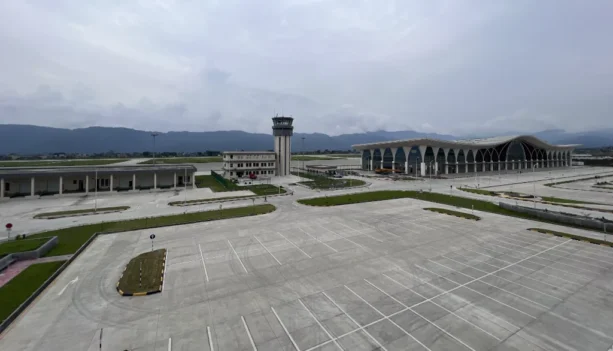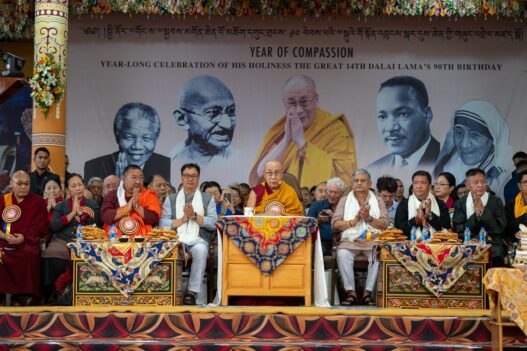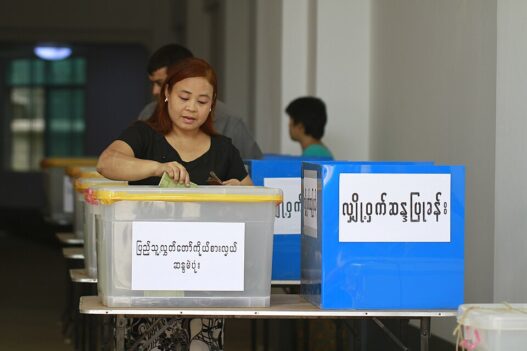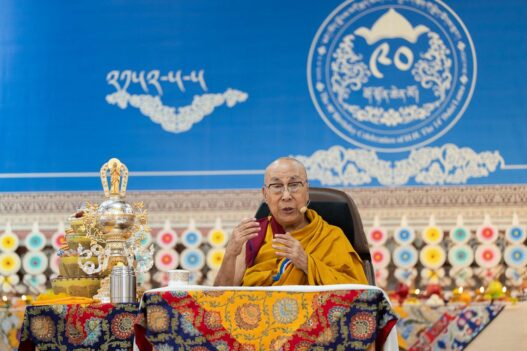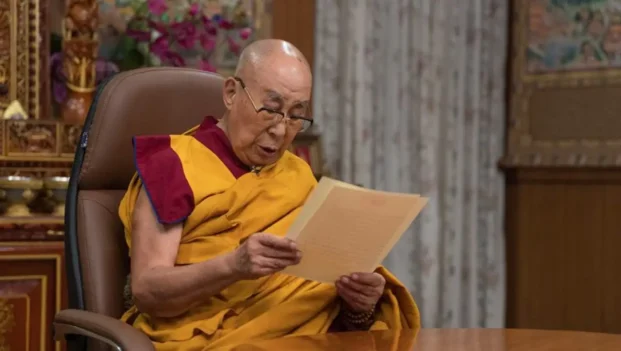“Truly, we are a peculiar people. We are all equals. Men and women have equal status. We have no caste divisions, no high class or low class of people, we believe in that form of democratic government which permits the rule not of the majority but of the people as a whole. We have no land tax, no wine tax, no water tax. Forests, rivers and woodland belong to the people for their exploitation without paying taxes. We have no beggars, and wonders of wonders, we have no jails. We do not ‘arrest’ or ‘imprison’ anybody…. We fear nobody, individually or collectively. We are a healthy people and fear corrupts the health of man…. We talk freely, live freely and fight freely too. We have no inhibitions of any kind…. Wild? Yes … But free. There is order in this chaos, law in this freedom. If we were to choose a country, it would be my Nagaland, my fair Nagaland – again and again”
– AZ Phizo
Northeast India is the easternmost region of India and comprises eight states: Arunachal Pradesh, Assam, Manipur, Meghalaya, Mizoram, Nagaland, Sikkim, and Tripura.
The Siliguri Corridor in West Bengal, with a width of 21 to 40 km, connects the North Eastern Region with Mainland India. The region shares an international border of 5,182 kilometres, with the neighbouring countries, 1,395 kilometres, with Tibet Autonomous Region, China in the north, 1,643 kilometres, with Myanmar in the east, 1,596 kilometres with Bangladesh in the south-west, 97 kilometres with Nepal in the west and 455 kilometres with Bhutan in the north-west. It comprises an area measuring 262,230 square kilometres, almost eight per cent of that of India. They are predominantly inhabited by tribal people with a degree of diversity even within the tribal groups. The region’s population results from ancient and continuous flows of migrations from Tibet, the Indo-Gangetic region, the Himalayas, present Bangladesh, and Myanmar. What distinguishes these states from the rest of the country is the sensitive geopolitical location with the existence of diverse ethnic groups with different historical backgrounds.
The North East as a whole is not a single entity with a common political destiny; rather it comprises eight different states. The Tribal communities in Northeast India are living on the fringe of three great political communities, India, China and Burma.
Historically, some of these communities played the roles of buffer communities, and others the roles of bridge communities between these three great political communities. This region is of great geopolitical importance to the Indian sub-continent due to its terrain, location and peculiar demographic dynamics, and is one of the most challenging regions to govern. However, its 40 million population accounts for only 3.1% of the Indian population. Post-independence, the history of this region has been marred by bloodshed, tribal feuds and under-development. Protracted deployment and operations by the army and the Assam Rifles have been instrumental in reducing of the levels of violence and restoring the security situation to ensure that civil governance elements can function. But over the years, the governance of the region continues to be a challenge.
In 1817, the Burmese empire invaded Assam and in 1819, annexed the independent Kingdom of Manipur. In 1823, they also annexed the Kingdom of Cachar, a strategic area for the impending invasion of Bengal. In March 1824, Britain officially declared war on Burma, a war which ended two years later with the signing of the Treaty of Yandabo. The Nagas emerged as a political entity on 24th February 1826, the day representatives of the Kingdom of Burma and the British military signed the Treaty of Yandabo, in which Burma renounced all claims to Assam and Manipur. This westward expansion pursued by Burma which was at that time, the most powerful kingdom in Southeast Asia had begun in the 1780s when Burmese troops occupied the independent Kingdom of Arakan and crossed for the first time the eastern border of the British Indian Empire, which corresponds with the present-day borders of Bangladesh and North Bengal. Gradually Britain occupied the whole of Assam and intensified its diplomatic and military relations with Manipur, which was intended to have a key position in monitoring and if need be defending the border between Burma and the British sphere of influence.
Origins of the Naga Insurgency- Understanding the Past
“If the British government, however, wants to throw us away, we pray that we should not be thrust into the mercy of the people who could never have conquered us themselves, and to whom we were never subjected but leave us alone to determine for ourselves as in ancient times.” Naga Club memorandum.
The origin of Naga dissent or the beginning of the thought of an insurgency is traceable to colonial patronage and probably manifested itself in the British backing of a rudimentary “club” in 1918. It was called the “Naga Club” and consisted informally of some Naga government officials, which submitted a memorandum to the Simon Commission on 10 January 1929. All 20 signatories were mainly from Kohima, mostly from the Angami tribe. No representative of any other Naga tribe met the Simon Commission, wherein they explained to them that “You (British) are the only people who have ever conquered us and when you go, we should be as we were”. Socio-economic issues raised pertained to poor education; a small population and fear of an impending “alien” rule. They feared that their minority presence in the Council of the Assam province would be politically inconsequential. The text of the memorandum showed the emergence of “ethnic solidarity”
The Naga Club further induced the birth of several tribal-based Naga councils, the Lotha council 1923, the Ao council 1928 and several others by the mid-1940s. British officials persuaded the Nagas to change the name of the Naga Club to the “Naga Hills District Tribal Council” in 1945.
The Birth of the Naga National Council and Phizo
“The Naga insurgent groups hold that theirs is an independence movement and not secessionist. The argument is that they lost their freedom to the British as did India and that the colonial power ruled both from Delhi as a matter of convenience, even as they fragmented the Naga peoples by placing them under different administrative jurisdictions within India and Burma, which was long administratively part of India until 1937. Hence, when the British departed in 1947 both India and the Naga people became independent.”
BG Verghese
This Council acquired a new name, “Naga National Council” (NNC) in 1946. The NNC initially advocated a simple approach of protest though it matured as a viable political organisation representing the “genuine grievances” of the Naga tribes. The NNC submitted a four-point memorandum to the government on 19 June 1946, and desired to be constitutionally included in an autonomous Assam with local autonomy and “a separate electorate” for them. The irony was that the NNC was born as a pro-government moderate body intending to improve the economic condition of the Nagas through constitutional means.
Hyderi- Naga Agreement 26-28 June 1947
The NNC, in a landmark move, signed a “Nine-Point Understanding” with the Government of India, represented by the British Governor of Assam, Akbar Hydri during 27-29 June,1947. Clause 9 of above Understanding mentioned the “renewal” or the “re-negotiating” of a new agreement after 10 years. Various historical events contributed, in different ways, to the growth of Naga dissent and the subsequent start of the “insurgency”. Phizo’s calls for independence provided a direction to the movement, mainly to the faction he led. Thus, the small NNC “Independence group”, which declared, with Phizo, Naga independence on 14 August 1947, consisted mostly of members from the Khonoma village and consisted mainly of the southern and east Angami group, most of them being “relations” of Phizo. Despite Phizo’s declaration of Naga independence, there was no furious outbreak of movement or insurgent activity. Rather, in a peaceful atmosphere, on 15 August 1947, the NNC only insisted on the implementation of the “Nine-Point Understanding between Akbar Hydari and the NNC signed in Kohima on 26-28 June 1947”, which the Government of India did not accept.
Growth of Violence and the Start of an Armed Insurgency.
By June 1955, a rift between Phizo’s extremist group and the moderates widened and inter-factional assassinations commenced. Many of those who opposed Phizo were assassinated, prominent among them being the distinguished T Sakhire, Imkongliba and “General” Kaito Sema. At this juncture, a small section of the supporters took Phizo to Zeliang Naga area and thence to Dacca on 6 December 1956. The then Pakistani government arranged for an El Salvador passport for Phizo, and he reached Zurich in May 1959. Michael Scott, who was once a member of the peace mission, reportedly helped Phizo get to London on 20 June 1960.
The 16 Point Agreement and the Birth of the State of Nagaland.
In 1956, the NNC declared formation of the underground “Federal Government of Nagaland”. The underground activists started forcible recruitment drive alongside killings of the informers and other dissidents. Increased eruption of violence in Nagaland could be traced from 1955 onwards, as Indian forces were inducted and tried to quell the Naga secession efforts. Armed Insurgency began in March 1956. Rapid mobilisation began, and due to differences of ideology, Nagaland was just a district (Naga Hills district) of Assam until 1957.
In order to change this status, some Nagas, who were earlier with the NNC, informally discussed other avenues and started the Naga People’s Convention (NPC) and chose Imkongliba Ao as its president. NPC remained very active and organised three Naga People’s Conventions during 1957 and 1960. In its very first session held at Kohima from 22-26 August 1957, the NPC proposed for a larger administrative unit by merging the Naga majority Tuensang division of the then North-East Frontier Agency (NEFA) with the Naga Hills district. Nehru met the NPC delegation on 25 September 1957 to discuss this issue. In July 1960, following discussions between PM Nehru and the leaders of the Naga People Convention (NPC), a 16-point agreement was arrived at whereby the Government of India recognised the formation of Nagaland as a full-fledged state within the Union of India. An interim body of 42 members was constituted, which functioned as the de facto council of ministers from February 1961, with Imkongliba Ao as chairman of the interim body and P Shilo as chief executive councillor. Shilo went on to become the first chief minister of Nagaland. This 16-point agreement was unique in many ways. It acknowledged the distinct status of the Nagas within the India federal system. It ensured that no act or law passed by Parliament would affect the religious and social practices of the Nagas, their customary laws and procedure of criminal justice would have no influence in the new state unless passed by a majority vote of the Nagaland legislative assembly. The 13th amendment of the Constitution by which the state of Nagaland was created, not only showed that the Indian democratic system could be flexible but also revealed the accommodative capacity of the Indian Constitution. Gradually a significant section of the Nagas came to concede that the 16-point agreement fulfilled most of their aspirations. But the NNC argued that the 16-point agreement was a complete “sellout” of the Naga political cause. Ultimately the growing animosity between the NNC and the NPC resulted in the assassination of Imkongliba.
The establishment of the state of Nagaland led to another turning point because, by this time, a sizeable group of “overground” Naga leaders had emerged, who chose to participate in the electoral democratic political system, which resulted in the formation of the Nagaland Nationalist Organisation (NNO). A second political party emerged in the shape of the Democratic Party of Nagaland, which was formed by those who differed from the NNO leadership and harboured sympathy for the secessionist underground group. In the aftermath of the total boycott of two Indian general elections of 1952 and 1957, the NPC and the Interim Body confronted the first test of “democracy” and successfully organised the general elections in Nagaland during January 1964. Amazingly, over 70% of Nagas exercised their franchise. This set-in motion the growth and maturing of electoral politics in Nagaland and caused a setback to the insurgency. This has continued ever since, right till the national elections of 2019.
The Naga Peace Process Amid Factionalism
The ongoing Indo-Naga peace process has continued over the past several decades and still eludes culmination. The peace talks of the 1960s had resulted in several Naga People’s Conventions, the 16-point agreement and the establishment of the “Peace Mission” consisting of Michael Scott, an Anglican pastor, Jayaprakash Narayan, and BP Chaliha the then chief minister of Assam which resulted in a “Cessation of Fire” or a Cease Fire, which first commenced from 23 May 1964. By 1966-67, the venue of the peace talks shifted to New Delhi where six rounds of talks were held, but meanwhile, the NNC, the Naga Federal Government (NFG) and the Federal Army aggressively increased their bloodshed. On 3 August 1968, “General” Kaito was assassinated. On 8 August 1972, chief minister Hokishe Sema had a miraculous escape and his daughter was seriously injured.
By the end of 1968, an anti-communist faction calling itself the “Revolutionary Government of Nagaland” came into being, and then followed a series of splits within the NNC and NFG, largely along “tribal” lines. The government did not extend the ongoing ceasefire and active hostilities restarted. The Nagaland Peace Council was formed again at the initiative of the church leaders along with a liaison committee which succeeded in persuading the underground leaders, who sent six representatives to have discussions. After more than five rounds of talks were held, these talks resulted in the signing of the “The Shillong Accord”.
Shillong Accord and Why it Failed
This Accord was signed at Shillong, Meghalaya, on 11 November 1975; The Naga leaders who signed this accord represented the NFG and NNC where they accepted the surrender of their arms and personnel. The outcome of the discussions was compiled into a three-point agreement: –
(a) The representatives of the underground organisations conveyed their decision, of their own volition, to accept, without condition, the Constitution of India.
(b) It was agreed that the arms, now underground, would be brought out and deposited at appointed places. Details for giving effect of this agreement will be worked out between them and representatives of the Government, the security forces, and members of the Liaison Committee.
(c) It was agreed that the representatives of the underground organisations should have reasonable time to formulate other issues for discussion for final settlement.
Clause 3 of the accord stated that “reasonable time would be given for the underground representatives to formulate other issues for discussion for the final settlement,”. This has remained unimplemented since many of the Naga National Council (NNC) leaders who were living abroad didn’t agree to endorse the agreement. They even criticized the agreement saying that the agreement was signed by “representatives of the Naga underground,” rather than the organizations like NNC or the Federal Government of Nagaland (FGN). During the negotiations prior to signing the agreement, Isak Chisi Swu, then-NNC Vice-president, and Thuingaleng Muivah, then-NNC General secretary, along with 150 insurgents who were in Burma, returning from China at that moment, rejected the agreement terming it as a “betrayal” by the NNC and censured it as a complete “sell-out” of the Naga rights, and swore to fight for unquestionable sovereignty. This led to the creation of a group called the National Socialist Council of Nagaland (NSCN) which split from their old organization the NNC on 2nd February 1980.
The Birth of the NSCN and the Present Situation
The Shillong Accord did not lead to peace but instead led to a split within the NNC, which further led to the creation of the NSCN in 1980. The manifesto of the NSCN was based on the principle of “socialism” for economic solution backed by a spiritual outlook of “Nagaland for Christ”. Later, animosity developed within the leadership of NSCN and two factions, the NSCN (I-M) and NSCN (Khaplang) emerged by April 1988. The NNC, too, post-Phizo’s death split into two factions, one led by Adinno, Phizo’s daughter and the other by Khadao Youthan, an old associate of Phizo. Clashes amongst these factions resulted in a large number of Nagas, including those not connected to these groups, being killed. NSCN (K) further split in 2011 to form a splinter group called NSCN (Khole- Khitovi (KK)) which further split into NSCN (Khitovi-Neokpao) (NSCN (KN)). Prolonged violence gave way to hope of peace when NSCN (IM) signed a CF with GoI in 1997 followed by NSCN (K) in 2001. NSCN (KK), on formation, signed a CF with the Government. In 2012, NSCN (K) also entered into a CF Agreement with Government of Myanmar. Several attempts for peace in the past have not borne the expected results. The progress of talks between UG groups and the Government of India suffered a setback in 2015 with NSCN (K) unilaterally abrogating the CF Agreement. This decision of the group led to another split and resulted in the formation of NSCN (Reformation). NSCN (K) further went on to join hands with ULFA (I), NDFB (S) and KYKL to form the United National Liberation Front of Western South East Asia (UNLFW). In short, over the years, every group further split into smaller factions, some more rabidly violent and extreme. This made the prevailing situation even more difficult to deal with.
The Framework Agreement 2015
Termed as “historic” by PM Modi, this agreement was signed after over 80 rounds of talks between the government and various stakeholders. The details of this agreement have yet to be declassified. In a statement, the government said it “recognised the unique history, culture and position of the Nagas and their sentiments and aspirations and hoped that ‘Through the Agreement, the GOI assured its pledge not only ‘to heal wounds and resolve problems’ but also to be the partner of the Nagas in their ‘pride and prestige. To the leaders and the people of Nagaland, the Prime Minister had a special message ‘You will not only build a bright future for Nagaland, but your talents, traditions and efforts will also contribute to making the nation stronger, more secure, more inclusive and more prosperous, further, You are also the guardians of our eastern frontiers and our gateway to the world beyond”. Later a similar framework agreement was signed with the NNPGs (Naga National Political Groups) with consists of seven groups including the NSCN (Reformation), the NSCN (NK) and the splinter group of the NSCN (Khango) and NSCN (Nikki Sumi).
NSCN (IM) signed a ‘Framework Agreement with the Government of India, which though unclassified till now, apparently lays down the ‘framework’ for future talks/resolution. Unfortunately, the Naga tribes remain divided and this has allowed peripheral issues to be highlighted. Some of these peripheral issues include the demand by the Eastern Naga People’s Organisation (ENPO) for a separate ‘Frontier Nagaland’ state and the growth of several other organisations, each more radical than the its earlier parent.
Further, this framework agreement has not led to permanent peace and in August 2020, the NSCN (IM) released copies of the confidential Framework Agreement and insisted on changing the interlocutor and Nagaland Governor Mr RN Ravi. Later in October 2020, the current chief of NSCN IM Muivah expressed strong reservations against moving forward with the agreement in an interview with Karan Thapar.
Is there a Solution? View of Past Leaders
Jayaprakash Narayan (JP), in his interactions with the Nagas, showed incredible comprehension and empathy about their history and origin. He traversed the length and breadth of Nagaland, later bringing out a book, “Nagaland Mein Shanti Ka Prayas” (The Attempts to Forge Peace in Nagaland). He was perhaps one of the first national leaders to argue about a civilisational unity in India which preceded its political unity. JP was speaking about all the tribes inhabiting India’s easternmost periphery, much before the term “India” was coined to define this country. Even today the tribes of this region are not influenced by the “Indian” culture. They are proud inheritors of their own unique culture.
Anthropologist B K Roy Burman in 2004 had suggested a solution through a non-territorial jurisdiction with legislative, administrative, judicial and development-oriented powers by constituting coordinating bodies. In October 1993, Roy Burman proposed “internal self-determination” for people like the Nagas, which implied the right of people to determine their own social, economic and political system, to depose their resources and to create conditions for their own development within an existing state.
Epilogue
It may be argued that ever since the signing of the ceasefire in August 1997, several rounds of talks have been held in India and abroad. NSCN (I-M) had held their last discussions in December 2020 and would probably be re-joining these talks again in 2021. The ongoing talks, led by the erstwhile government-appointed interlocutor, Mr Ravi, the Governor of Tamilnadu, failed. “The Union government broadened the scope of the peace talks by roping in six other Naga armed groups, who later formed the umbrella organisation Naga National Political Groups, (NNPGs). In 2019, post the death of Khaplang, the Khango Konyak-led splinter faction of the NSCN (Khaplang) accepted the Cease Fire and joined talks along with the NNPGs. While the involvement of these groups in the talks, offered the Union government a better bargaining position, the NSCN (IM) felt that it was done to undermine its influence. During the current phase of ongoing negotiations, the NSCN (I-M)’s insistence for a separate flag and constitution for the proposed Nagalim has emerged as the major stumbling block in inking the Naga accord.” As a consequence, the NSCN (IM), started losing trust in the interlocutor by July 2020 and refused to interact with him thereafter. Later the government appointed a senior official of the Intelligence Bureau Mr Mishra as the interlocutor, to continue the talks.
The main issue, “sovereignty” to include a separate flag and constitution has become difficult to resolve. Can our government deal with this vexed sovereignty in a more flexible manner? Can the NSCN dilute their stand? The answers to these questions lie in our ability to trust each other. We have had innovative solutions in the past, and we certainly can come up with an acceptable solution now. However, what needs to be asked is whether such a political solution is possible within our constitutional federal system? The fact that the Naga leaders have almost moved away from the original demand for “independence” brings great hope for peace. The federal principles enshrined in the Constitution allow a great deal of flexibility relating to the “autonomy” of particular areas and people. We need pragmatism and the imperatives of peace, demand that the ultimate aim of a permanent agreement should not be derailed again. In fact, the need for circumspection is greater now than ever before. The current phase of peace parleys should not be left halfway for yet another future futile failed accord. There’s no doubt that an end to “Naga insurgency” will have an enormous impact on the prevailing peace within tribal north-eastern societies. The success of our Look East policy too will depend, in the long run, on the success of these peace talks.
It is clear that the mainstream Naga society and its youth have in itself undergone a huge transformation over the last 30 years and today’s educated Naga youth identifies with the idea of India and are increasingly looking both at economic and political advantages of being part of the larger federal democratic system of India. Unfortunately, concerns about the vast number of weapons held by the insurgents, increased militarisation and brutalisation of its society, fuelled by six decades of continuous armed conflict need to be addressed and rectified as soon as possible. What is further essential is that regardless of a political solution, we must find a way to re-assign and convince the approximately 4000 armed cadres of the various groups to give up their weapons and accept a handsome stipend and job oriented training instead. This will remove the armed cadre and the weapons from the hands of the leadership and hopefully force an ‘acceptable political solution’.
It also is clear that the threat from China today is real and has affected and altered the external and internal security environment of the North East. Further, coupled with its use of cyber – warfare, increased cross-border terrorism, the emergence of non-state actors, the growth of Islamic fundamentalism, the narcotics-arms nexus, illegal migration and left-wing extremism, gravely impact the security of our already fragile North East. Permanent peace in this region is absolutely necessary and cannot be delayed any further.

